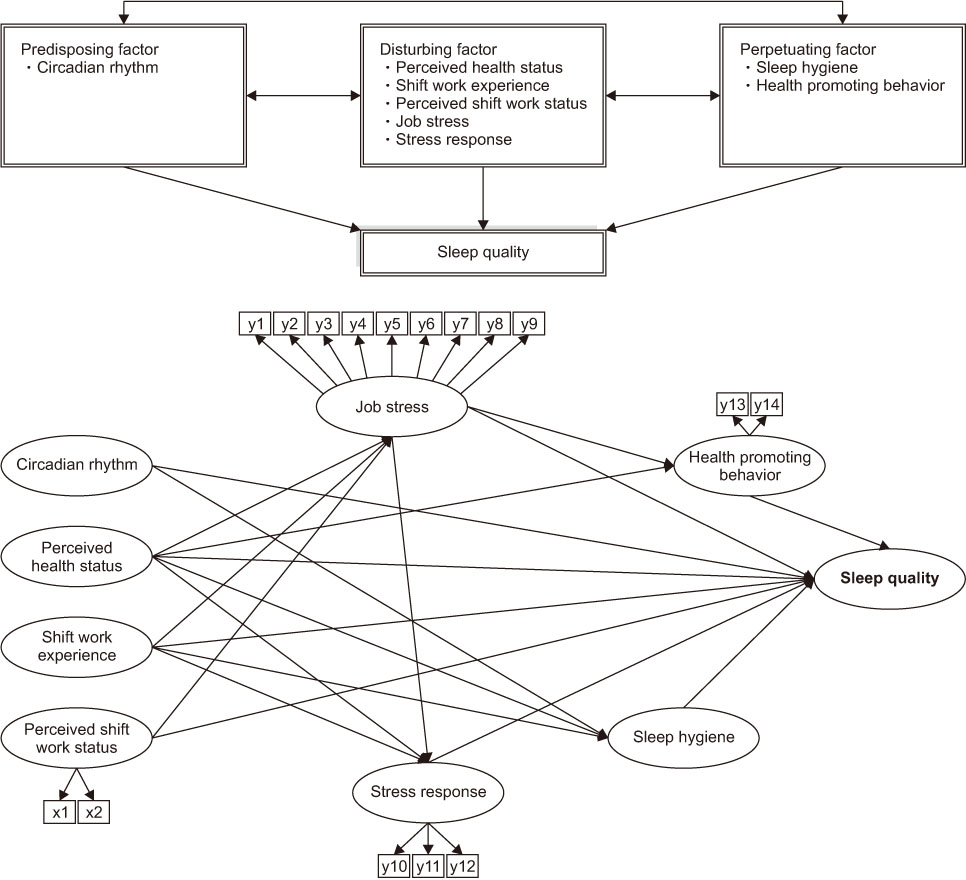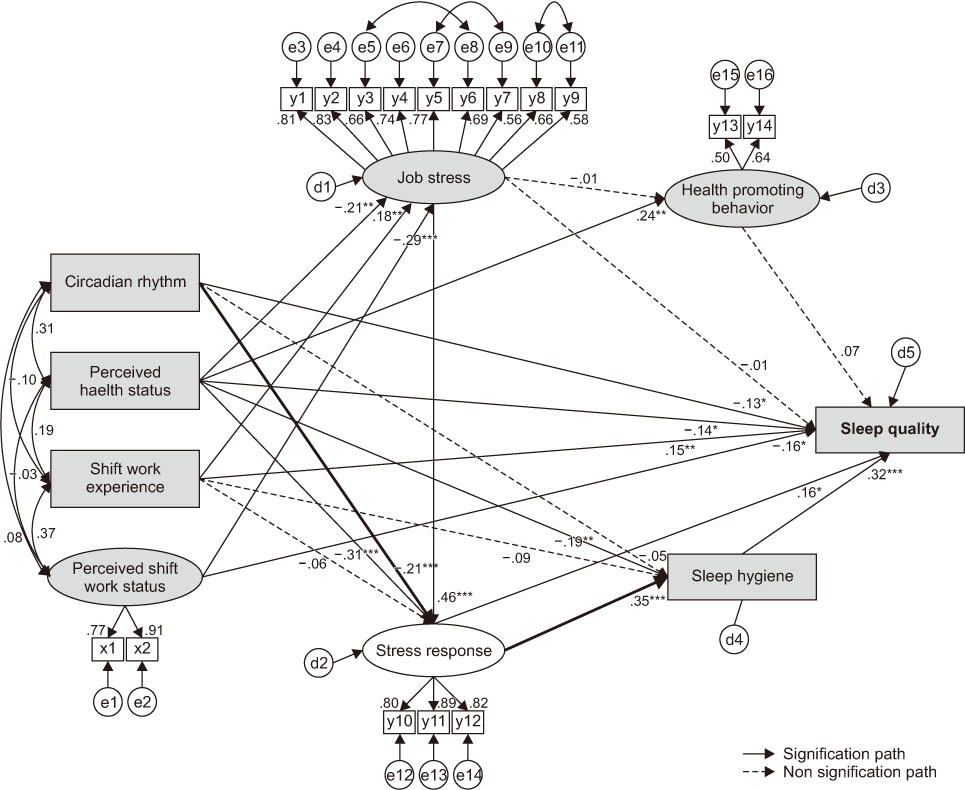J Korean Acad Nurs.
2018 Oct;48(5):622-635. 10.4040/jkan.2018.48.5.622.
Structural Equation Model for Sleep Quality of Female Shift Work Nurses
- Affiliations
-
- 1Department of Nursing, Samsung Changwon Hospital, Sungkyunkwan University, Changwon, Korea.
- 2College of Nursing · Gerontological Health Research Center in Institute of Health Sciences, Gyeongsang National University, Jinju, Korea. mogu@gnu.ac.kr
- KMID: 2424367
- DOI: http://doi.org/10.4040/jkan.2018.48.5.622
Abstract
- PURPOSE
This study aimed to develop and test a structural model for sleep quality in female shift work nurses. The hypothetical model was constructed on the basis of Spielman's 3P model of insomnia and previous research related to the sleep quality of shift nurses.
METHODS
This cross-sectional study used structural equation modeling and recruited 285 female shift work nurses from four general and university hospitals with over 300 beds located in C and J cities in Gyeongsangnamdo. Data were collected from September 27 to October 20, 2016, and then analyzed using descriptive statistics, Pearson's correlation, and structural equation modeling. The study used SPSS/Win 18.0 and AMOS 18.0 in processing the data.
RESULTS
The final model showed good fit to the empirical data: χ2/df=2.19, SRMR=.07, RMSEA=.07, AGFI=.85, TLI=.91, GFI=.93, GFI=.89, NFI=.87. The factors that influenced sleep quality were sleep hygiene (β=.32), perceived shift work status (β=−.16), stress response (β=.16), shift work experience (β=.15), perceived health status (β=−.14), and circadian rhythm (β=−.13) explaining 36.0% of the variance.
CONCLUSION
The model of sleep quality of the shift work nurses constructed in this study is recommended as a model to understand and predict the sleep quality of shift work nurses. The results suggest that strategies for improving the sleep quality of shift work nurses should focus on sleep hygiene, perceived health status, stress response, circadian rhythm, perceived shift work status, and shift work experience.
Keyword
MeSH Terms
Figure
Reference
-
1. Moul DE, Nofzinger EA, Pilkonis PA, Houck PR, Miewald JM, Buysse DJ. Symptom report in severe chronic insomnia. Sleep. 2002; 25(5):548–558. DOI: 10.1093/sleep/25.5.548.2. Taylor DJ, Mallory LJ, Lichstein KL, Durrence HH, Riedel BW, Bush AJ. Comorbidity of chronic insomnia with medical problems. Sleep. 2007; 30(2):213–218. DOI: 10.1093/sleep/30.2.213.
Article3. No OJ, Song MS, Kim KM, Eom OB, Han OH, Kim MJ, Hong JH. 2013 Survey on the status of hospital nursing staffing [Internet]. Seoul: Korea Hospital Nurses Association;c2013. cited 2016 Dec 1. Available from: http://khna.or.kr/web/notice/news.php.4. Liu X, Uchiyama M, Kim K, Okawa M, Shibui K, Kudo Y, et al. Sleep loss and daytime sleepiness in the general adult population of Japan. Psychiatry Res. 2000; 93(1):1–11. DOI: 10.1016/S0165-1781(99)00119-5.
Article5. Pilcher JJ, Ginter DR, Sadowsky B. Sleep quality versus sleep quantity: Relationships between sleep and measures of health, well-being and sleepiness in college students. J Psychosom Res. 1997; 42(6):583–596. DOI: 10.1016/S0022-3999(97)00004-4.
Article6. Kwon GJ. A study on shift work nurses' sleeping pattern according to their fatigue level and working type [master's thesis]. Seoul: Ewha Womans University;2005. 1–56.7. Han KS, Park EY, Park YH, Lim HS, Lee EM, Kim L, et al. Factors influencing sleep quality in clinical nurses. J Korean Acad Psychiatr Ment Health Nurs. 2011; 20(2):121–131. DOI: 10.12934/jkpmhn.2011.20.2.121.
Article8. Kim HS, Choi KS, Eom M, Joo EJ. Role of circadian types and depressive mood on sleep quality of shift work nurses. Korean J Psychopharmacol. 2011; 22(2):96–104.9. Shin SW, Kim SH. Influence of health-promoting behaviors on quality of sleep in rotating-shift nurses. J Korean Acad Fundam Nurs. 2014; 21(2):123–130. DOI: 10.7739/jkafn.2014.21.2.123.
Article10. Hong KS. A Study on daytime sleepiness, insomnia, and the quality of sleep in clinical nurses [master's thesis]. Jeju: Jeju National University;2015. 1–74.11. Jeong JY, Gu MO. The influence of stress response, physical activity, an sleep hygiene on sleep quality of shift work nurses. J Korea Acad Ind Coop Soc. 2016; 17(6):546–559. DOI: 10.5762/KAIS.2016.17.6.546.12. Buysse DJ, Reynolds CF III, Monk TH, Berman SR, Kuper DJ. The Pittsburgh sleep quality index: A new instrument for psychiatric practice and research. Psychiatry Res. 1989; 28(2):193–213. DOI: 10.1016/0165-1781(89)90047-4.
Article13. Chien PL, Su HF, Hsieh PC, Siao RY, Ling PY, Jou HJ. Sleep quality among female hospital staff nurses. Sleep Disord. 2013; 2013:283490. DOI: 10.1155/2013/283490.
Article14. Edell-Gustafsson UM, Kritz EIK, Bogren IK. Self-reported sleep quality, strain and health in relation to perceived working conditions in females. Scand J Caring Sci. 2002; 16(2):179–187. DOI: 10.1046/j.1471-6712.2002.00078.x.
Article15. Yang EO, Choi IR, Kim SM. The impact of sleep disorder and job stress on turnover intention of shift working nurses. Korean J Stress Res. 2017; 25(4):255–264. DOI: 10.17547/kjsr.2017.25.4.255.16. Spielman AJ, Caruso LS, Glovinsky PB. A behavioral perspective on insomnia treatment. Psychiatr Clin North Am. 1987; 10(4):541–553. DOI: 10.1016/S0193-953X(18)30532-X.
Article17. Jang CH, Kim SH, Oh DH. Cognitive behavioral therapy of insomnia. Hanyang Med Rev. 2013; 33(4):210–215. DOI: 10.7599/hmr.2013.33.4.210.
Article18. Kim MY, Choi HJ. Factors influencing sleep patterns during clinical practice weeks among nursing students: Based on Spielman's Model. J Korean Biol Nurs Sci. 2016; 18(4):203–221. DOI: 10.7586/jkbns.2016.18.3.203.19. Jeong MS. The relationship between, job stress, quality of sleep and stress response among shift nurses [master's thesis]. Busan: Kosin University;2012. 1–72.20. Chung MH, Liu WI, Lee HL, Hsu N. Selected neurophysiological. psychological, and behavioral influences on subjective sleep quality in nurses: A structure equation model. PLoS One. 2013; 8(11):e79529. DOI: 10.1371/journal.pone.0079529.
Article21. Park JH. Health promoting behaviors and sleep quality of shift working nurses [master's thesis]. Gochang: Chonbuk National University;2013. 1–47.22. Kim BY. Job stress and related factors of nurses in a general hospital [master's thesis]. Gangneung: Kwandong University;2010. 1–67.23. Yeun EJ, Kim HJ, Jeon MS. Factors influencing health promoting behavior among hospital registered nurses: Mood states, resourcefulness, and health perception. J Korean Acad Nurs Adm. 2011; 17(2):198–208.24. Kim JS, Kim CJ. Association of job stress with health-promoting behaviors and health status in clinical nurses. Korean J Occup Health Nurs. 2016; 25(4):311–319. DOI: 10.5807/kjohn.2016.25.4.311.
Article25. Kim SJ, Gu MO. A study on the relationship among circadian types, sleep quality and adaptation to night shifts among nurses working on two or three day night duties. J Korean Clin Nurs Res. 2013; 19(3):309–320. DOI: 10.22650/JKCNR.2013.19.3.309.26. Yu JP. The concept and understanding of structual equation modeling. Seoul: Hannare Publishing Co.;2012. p. 1–391.27. Mastin DF, Bryson J, Corwyn R. Assessment of sleep hygiene using the sleep hygiene index. J Behav Med. 2006; 29(3):223–227. DOI: 10.1007/s10865-006-9047-6.
Article28. Cho YW. Measures of sleep and sleep hygiene. J Korean Sleep Res Soc. 2004; 1(1):12–23.29. Smith CS, Reilly C, Midikiff K. Evaluation of three circadian rhythm questionnaires with suggestions for an improved measure of morningness. J Appl Psychol. 1989; 74(5):728–738. DOI: 10.1037//0021-9010.74.5.728.
Article30. Horne JA, Östberg O. A self-assessment questionnaire to determine morningness-eveningness in human circadian rhythms. Int J Chronobiol. 1976; 4(2):97–110.31. Torsvall L, Åkerstedt T. A diurnal type scale. Construction, consistency and validation in shift work. Scand J Work Environ Health. 1980; 6(4):283–290. DOI: 10.5271/sjweh.2608.
Article32. Kim JK. Circadian rhythm and psychological adjustment. Korean J Health Psychol. 1998; 3(1):129–140.33. Kook SH, Yoon JS, Lee HY. Cross validation of the Korean translation of composite Scale(KtCS) to measure morningness-eveningness. J Korean Neuropsychiatr Assoc. 1999; 38(2):297–305.34. Speake DL, Cowart ME, Pellet K. Health perceptions and lifestyles of the elderly. Res Nurs Health. 1989; 12(2):93–100. DOI: 10.1002/nur.4770120206.
Article35. Kweon YR, Jeon HO. Effects of perceived health status, self-esteem and family function on expectations regarding aging among middle-aged women. J Korean Acad Nurs. 2013; 43(2):176–184. DOI: 10.4040/jkan.2013.43.2.176.
Article36. Kim MJ, Gu MO. The development of the stress measurement tool for staff nurses working in the hospital. J Nurs Acad Soc. 1984; 14(2):28–37. DOI: 10.4040/jnas.1984.14.2.28.
Article37. Yun CG, Lee HN. A study on the job stress of nurses in hospital. J Health Inform Stat. 2003; 28(2):95–110.38. Koh KB, Park JK, Kim CH. Development of the stress response inventory. J Korean Neuropsychiatr Assoc. 2000; 39(4):707–719.39. Choi SM, Kang TY, Woo JM. Development and validation of a modified form of the stress response inventory for workers. J Korean Neuropsychiatr Assoc. 2006; 45(6):541–553.40. Walker SN, Sechrist KR, Pender NJ. The health-promoting life style profile: Development and psychometric characteristics. Nurs Res. 1987; 36(2):76–81. DOI: 10.1097/00006199-198703000-00002.41. Seo HM, Hah YS. A study of factors influencing on health promoting lifestyle in the elderly: Application of Pender's health promotion model. J Korean Acad Nurs. 2004; 34(7):1288–1297. DOI: 10.4040/jkan.2004.34.7.1288.
Article42. Yang CM, Lin SC, Hsu SC, Cheng CP. Maladaptive sleep hygiene practices in good sleepers and patients with insomnia. J Health Psychol. 2010; 15(1):147–155. DOI: 10.1177/1359105309346342.
Article43. Kline RB. Principles and practice of structural equation modeling. 2nd ed. New York: Guilford Press;2004. p. 1–366.44. Lee EO, Im NY, Park HA, Lee IS, Kim JI, Bae JI, et al. Nursing research and statistical analysis. Seoul: Soomoonsa;2009. p. 1–733.45. Kim GS. Analysis structural equation modeling. Seoul: Hannarae Publishing Co.;2010. p. 1–663.46. Hong SH. The criteria for selecting appropriate fit indices in structural equation modeling and their rationales. Korean J Clin Psychol. 2000; 19(1):161–177.47. Koran Occupational Safety a Health agency. Night work and Shift work Occupational Health guidelines [Internet]. Ulsan: Koran Occupational Safety a Health agency;c2013. cited 2016 Dec 25. Available from: http://www.kosha.or.kr/www/boardView.do?contentId=354389&menuId=5405&boardType=A.48. Pronitis-Ruotolo D. Surviving the night shift. Am J Nurs. 2001; 101(7):63–65. 67–68.
Article49. Korea Occupational Safety & Health Agency. Health care guidelines for shift workers [Internet]. Ulsan: Korea Occupational Safety & Health Agency;c2008. cited 2016 Dec 1. Available from: https://www.kosha.or.kr/cms/board/Download.jsp?fileId=63207.50. Kim HJ. Domestic an international night worker health care case [Internet]. Ulsan: Korea Occupational Safety & Health agency;c2012. cited 2016 Dec 1. Available from: https://oshri.kosha.or.kr/cms/board/Download.jsp?fileId=72530.
- Full Text Links
- Actions
-
Cited
- CITED
-
- Close
- Share
- Similar articles
-
- The Psychophysicosocial Distresses in Nurses with Shift Work
- Influencing Factors for Sleep Quality Among Shift-working Nurses:A Cross-Sectional Study in China Using 3-factor Pittsburgh Sleep Quality Index
- The Influence of Knowledge and Sleep Hygiene Performance on Sleep Disturbances Among Shift-Work Nurses
- Differences in Sleep, Fatigue, and Neurocognitive Function between Shift Nurses and Non-shift Nurses
- Secondary Data Analysis on the Quality of Sleep and Related Factors of Novice and Experienced Shift Work Nurses



